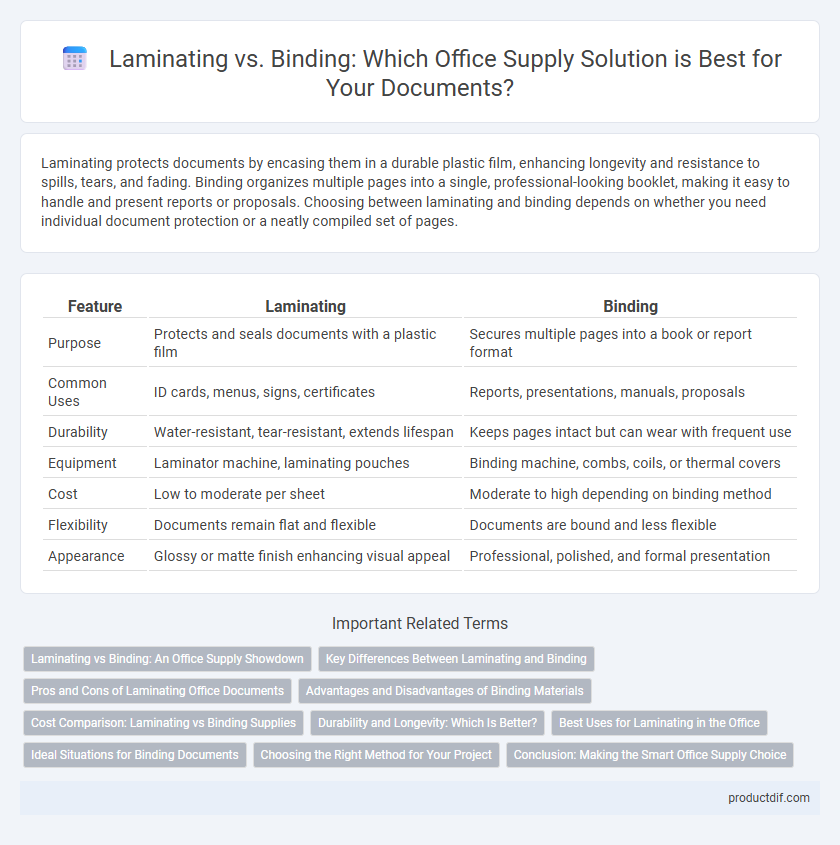Laminating protects documents by encasing them in a durable plastic film, enhancing longevity and resistance to spills, tears, and fading. Binding organizes multiple pages into a single, professional-looking booklet, making it easy to handle and present reports or proposals. Choosing between laminating and binding depends on whether you need individual document protection or a neatly compiled set of pages.
Table of Comparison
| Feature | Laminating | Binding |
|---|---|---|
| Purpose | Protects and seals documents with a plastic film | Secures multiple pages into a book or report format |
| Common Uses | ID cards, menus, signs, certificates | Reports, presentations, manuals, proposals |
| Durability | Water-resistant, tear-resistant, extends lifespan | Keeps pages intact but can wear with frequent use |
| Equipment | Laminator machine, laminating pouches | Binding machine, combs, coils, or thermal covers |
| Cost | Low to moderate per sheet | Moderate to high depending on binding method |
| Flexibility | Documents remain flat and flexible | Documents are bound and less flexible |
| Appearance | Glossy or matte finish enhancing visual appeal | Professional, polished, and formal presentation |
Laminating vs Binding: An Office Supply Showdown
Laminating preserves important documents by encasing paper in a protective plastic layer, enhancing durability and water resistance for frequent handling in office environments. Binding securely holds multiple pages together, offering a professional presentation for reports, proposals, and manuals, with options including spiral, comb, and thermal binding. Choosing between laminating and binding depends on whether protection or page organization is the priority in office supply needs.
Key Differences Between Laminating and Binding
Laminating applies a protective plastic film over documents to enhance durability and resistance to water, dirt, and tearing, while binding physically fastens multiple pages together to create a single, cohesive unit like a booklet or report. Laminated items remain flexible and are ideal for frequently handled materials such as ID cards and menus, whereas binding offers structured organization for multi-page presentations, reports, and manuals. Choosing between laminating and binding depends on the need for surface protection versus document compilation and presentation style.
Pros and Cons of Laminating Office Documents
Laminating office documents offers superior protection against water, dirt, and wear, extending the lifespan of frequently handled materials such as ID cards, menus, and instructional sheets. However, laminating can be costly for large volumes, creates a rigid finish that prevents updating or editing, and may generate non-recyclable waste. Choosing laminating is ideal for preserving important documents needing durability but not recommended for items requiring frequent changes or environmentally conscious offices.
Advantages and Disadvantages of Binding Materials
Binding materials offer durability and professional appearance, making them ideal for reports and presentations that require repeated handling. Common options like spiral, comb, and thermal binding provide flexibility in document size and customization but may vary in cost and ease of use. Limitations include potential damage to pages during binding and reduced ability to update documents compared to laminating, which primarily enhances protection without altering the document structure.
Cost Comparison: Laminating vs Binding Supplies
Laminating supplies generally incur a higher upfront cost due to the price of laminating machines and thermal pouches, whereas binding supplies, such as binding combs, spines, and covers, tend to be more affordable and have lower ongoing costs. The cost-effectiveness of binding is amplified by the availability of budget-friendly manual binding machines, while laminating requires frequent replacement of consumables like laminating sheets. Small businesses and offices with moderate document preservation needs often find binding supplies more economical than investing heavily in laminating equipment and materials.
Durability and Longevity: Which Is Better?
Laminating enhances durability by creating a protective plastic layer that resists moisture, stains, and wear, making documents last longer in high-use environments. Binding, while offering structural support and neat organization, does not provide the same level of surface protection and may be prone to damage from frequent handling. For maximum longevity, especially in preserving individual sheets, laminating is generally the better option.
Best Uses for Laminating in the Office
Laminating is ideal for protecting important documents such as ID cards, menus, and frequently handled reference sheets, ensuring durability and resistance to wear and tear. It provides a waterproof and tear-resistant seal, making laminated materials suitable for high-traffic office environments and frequent use. Laminating is best for preserving signage, instruction manuals, and certificates, extending their lifespan without altering the original content.
Ideal Situations for Binding Documents
Binding documents is ideal for presentations, reports, and professional portfolios that require a polished, durable finish with easy page-turning capabilities. It is best suited for multi-page documents that need to be frequently referenced or mailed without damage. Binding options like spiral, comb, or thermal provide flexibility in document size and allow for the addition or removal of pages as needed.
Choosing the Right Method for Your Project
Laminating provides a durable, protective layer ideal for preserving documents exposed to frequent handling or moisture, making it perfect for menus, ID cards, and instructional materials. Binding offers a professional and organized presentation, suitable for booklets, reports, and manuals that require easy page turning and a polished look. Selecting between laminating and binding depends on the project's purpose, durability needs, and desired aesthetic, ensuring optimal preservation and usability.
Conclusion: Making the Smart Office Supply Choice
Choosing between laminating and binding depends on the intended document use and durability needs; laminating offers water-resistant protection ideal for frequently handled papers, while binding provides a polished, professional presentation suited for reports and booklets. Businesses prioritizing longevity and frequent referencing benefit from laminated materials, whereas those requiring structured, multi-page documents should opt for binding solutions like comb, spiral, or thermal binding. Evaluating staff workflow and document importance ensures an office supply decision that enhances efficiency and maintains document integrity.
Laminating vs Binding Infographic

 productdif.com
productdif.com